
You are reading the older HTML site
Positive Feedback
ISSUE
25
may/june
pmc
FB1+ loudspeakers
as reviewed by Sasha Matson
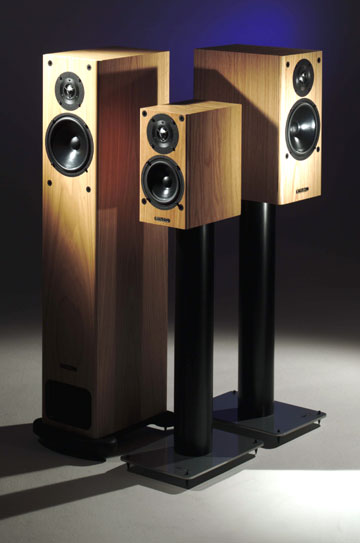
Models FB1, TB2, and DB1 Loudspeakers
|
SASHA MATSON'S SYSTEM
LOUDSPEAKERS
ELECTRONICS
SOURCES
CABLES
ACCESSORIES
|
Bad Intelligence.
I have a scoop for you; honestly, I think I do. You have been getting bad intelligence, incomplete intelligence, in which critical information has been withheld, and alternative interpretations have been suppressed. This is contributing to erroneous purchasing decisions vis a vis sound systems, and contributing to an apparent lack of a forward leaning posture in regards to the audio community, affecting your sonic readiness in the global war on aural terrorism. Heck, if Sam Tellig has his way, we'll all be listening to things made in France! But gosh, enough Rummy-speak……
Have your ever heard....of the British company PMC (Professional Monitor Corporation), and in particular their current floor-standing loudspeaker, the model FB1+? To be honest, I hadn't either, until Brian Smith at Audio Classics Ltd. in Binghamton, New York, (www.audioclassics.com), cleverly had me listen to a pair when I was there on another errand, trying to mind my own business. Audio Classics Ltd. is the licensed regional dealer for PMC in my area—you can find your dealer location by going to the PMC website at www.pmcloudspeaker.com.
As far as I can tell, there has been a real lack of coverage of PMC products by the American high-end audio press—somehow it has been flying below the radar of those critics. The only previous review I could find was by John Marks in The Absolute Sound, dated October 2000. Why is this? I really do not know, based on the exceptional quality of what I am hearing. Perhaps it is because PMC's reputation began in the professional audio marketplace, and relations between that world and the consumer high-end audio world are almost as strained as those between tube lovers and the solid-staters. But this is going to change, and I am here to do my bit.
The PMC FB1+ is a two-way floor-standing loudspeaker of modest dimensions, not unlike many dozens of loudspeakers on the market today in its basic appearance and finish. The FB1+ employs a 27mm silk soft dome ferrofluid-cooled unit, sourced from Vifa. This is an up-grade from the previous FB1 (non "+") model, and looks to be an almost identical unit to the tweeter in the Sonus Faber Grand Piano speakers I have also had on hand. The woofer in the FB1+ is a 170mm cast magnesium driver that is a PMC proprietary design manufactured specifically for them. There are removable foam grills.
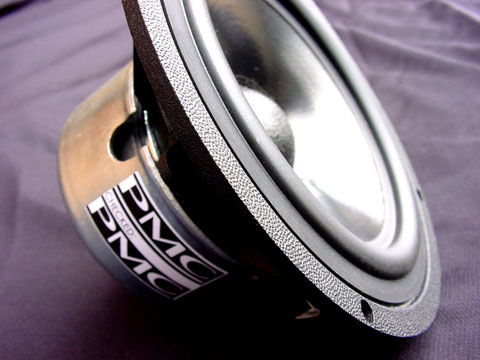
A Model DB1 Driver
That's it for the front panel, except for a smallish foam-covered port at the very bottom—this is where the transmission line exits. (There are important differences between this and a reflex port). On the back are two pairs of nice quality gold-plated binding posts, with an included gold-plated jumper if you do not bi-wire or bi-amp them. I do not, so I have been using the supplied jumper. For the record, PMC is partnered with Bryston, the Canadian manufacturer of amplifiers, and Bryston designs specific amp units that may be directly attached to many of the PMC loudspeakers—and voila, you have a powered speaker.

FB1+ Rear Binding Posts
The FB1+'s with their included plinths stand about 42" high by a mere 8" wide and 12" deep. This should be acceptable in most domestic environments, and fits like a glove in one bay of our Edwardian living room. They are well finished—my pair were done in a handsome matched cherry veneer. However, there is one crucial internal difference that separates the FB1+ from the herd of similarly sized floor-standers out there: the FB1+ utilizes a transmission line loading design, as do all the other speakers produced by PMC. (More on this in a moment).
The stated frequency range of this two-way design is from 25khz down to flat response at 25hz and on down further to 22hz with a 3dB roll-off by that point. Let me say that again—the stated frequency range of this two-way design is from 25khz down to flat response at 25hz, and on down further to 22hz with a 3dB roll-off by that point. This is low for a two-way design! Efficiency is a specified 90dB, making them fairly tube friendly. Peak SPL@1 meter is stated as greater than 110dB, (and that's loud!). The FB1+'s are designated as an 8 ohm load, and the crossover is in the 3kHz neighborhood, employing a moderate 12dB/octave slope.
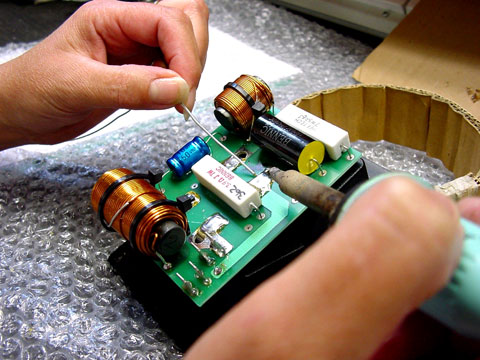
A Model DB1 Crossover
Here's the best part—you get all this for a current list price of $3.3k U.S., even given the sorry state of the dollar. There are no other full-range loudspeakers of this quality, that go down this far, at this price, listed in the current Stereophile Class A or B recommended components!
The FB1+ was the first model PMC designated primarily for consumer use, (though plenty of studios use them as well). It has since been joined by a number of smaller models, both stand-mounted and floor-standing, and one larger sibling, the model OB1, (was the Star Wars moniker deliberate I wonder?), which is a 3-way design. But those are another story, and I have not spent time with any of them as of yet. You can find out more about these options, of course, from the PMC website at www.pmcloudspeaker.com.
Intelligent Design
In order to appreciate what I feel makes the FB1+ special, it is necessary to understand a bit about the concept of transmission loading. As most everyone reading this probably knows, the dynamic driver loudspeaker, as opposed to planars in particular, is the most commercially viable means of reproduction of sound on this planet. Even the ever-expanding computer/digital interface shows no signs of changing this situation. But this is only the driver. There are several means of enclosing drivers in physical space that have evolved—by far, the most common is reflex loading.
Remember, you can't just hang a dynamic speaker on the wall and expect much in the way of sound, because the wave produced by the diaphragm as it oscillates backwards will wrap around to the front and lead to cancellation of the forward-moving wave. The infinite baffle, otherwise thought of simply as a ‘sealed-box' design, eliminates this behavior, but in the process yields somewhat low bass frequency output, due in part to air resistance retarding the free-movement of the driver, caused by compressing the air in a sealed chamber; the air inside the box has nowhere to go.
The common-sense real-world solution that has appealed to the majority of loudspeaker designers is the reflex-loading approach. Reflex cabinet designs allow some of the energy generated by the back and forth movement of dynamic drivers to escape to the outside of the cabinet through a vent or port. This venting is designed in order to produce a wave that exits in phase with the front-firing wave, thus reinforcing, rather than subtracting from the apparent sonic energy. There are pluses, and minuses, to this commonly used approach.
Reflex-loaded designs roll off at the low end at a steeper rate than infinite baffles; the bass goes deeper, but at a certain point it decreases more noticeably and rapidly. It is important to note in this context that transmission line designs share the gentler low-frequency roll-off behavior of their sealed enclosure design cousins, rather than the more abrupt behavior of reflex-loaded enclosures. Psycho-acoustically speaking, that gentler slope is perceived as the presence of more content in the lower end of the frequency spectrum. Reflex systems however, do yield more decibel output from a given volume than sealed enclosures—a definite reason they are so popular in this sub-woofer obsessed audio culture of ours.
The devil is in the details however: reflex-loaded ports, especially when front-firing, produce gobs of low frequency stuff—not all of it pretty. You could place your hand on the front-panel port of the reflex-loaded Sonus Fabers that the PMC's replace in my living room, and literally feel puffs of air between your fingers, like the compressed air that shoots out of those kids ‘super soaker' water guns. You get some of that behavior from transmission line ports, but it is greatly reduced. Long ago, the low-budget reflex-loaded dynamic speaker became the first refuge of audio scoundrels, (pace Franco Serblin, I certainly don't mean you!), where they reign in all their glory still, in those $99 surround sound systems at Best Buy.
The Road Less Traveled
The Professional Monitor Company was established in England in 1990 by Peter Thomas and Adrian Loader, Thomas bringing with him experience as a technical manager for the BBC. I spoke with Miles Roberts, Head of Sales for PMC, about some of the history:
"Peter (Thomas) has really been a lifelong exponent of high-end audio. He has had a passion for it since his early teens. He purchased a lot of the original transmission line designs. Studied the early designs by people like Bailey, right back into the mid-60's, and ended up being trained in pro audio by the BBC. (Thomas) designed a very large studio reference model the BB5, which is the biggest one we do, and then he had to make a decision about whether or not he was going to continue as an employee (of the BBC), or move into the commercial world and build these things for real."
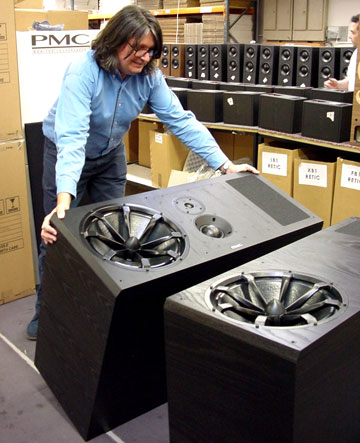
Designer Peter Thomas Hefts a BB5
I asked Miles Roberts to comment on the relationship between the audiophile high-end world and the pro audio setting, and he responded by saying, "At a certain level in the business, people are audiophiles—the people that set the standards at the end of the production train—the mastering. The trouble is, like everything in this commercial world, at the entry level it is driven by commercial realities. There are people putting large quantities of gear into broadcast that is quite often economy grade. This is a problem because the original edits and cuts are being done with poorer quality products, so by the time you get to the end of the chain, it's too late. Some companies are learning and are moving to higher end equipment."
Prior technical media expertise focused PMC during its initial years on producing monitors designed specifically for studio and other professional audio environments. Miles Roberts explained that "We started to move into the high-end market around 2000, and it really kicked off with the model you've got (the FB1). It has had quite a bit of staying power—it's still winning awards for us."
If you visit their website, (at www.pmcloudspeaker.com) you will find the majority of their extensive line is still intended for professional monitoring use, and in that arena PMC is known and respected. Miles Roberts pointed out that "the products were designed as an actual reference for the professional market; 65 to 70 per cent of most CD's are mastered using our equipment." PMC has also made its presence known in the film music end of things—many dubbing stages are PMC equipped, and indeed many of the current crop of film composers utilize PMC gear in their personal studios.
One can engage in a philosophical debate about what, if any, difference exists between the audiophile approach and the professional audio approach. For my money, this is a tired discussion that has become increasingly irrelevant, at least in terms of absolute sonic issues, and may just turn on cosmetic aspects alone at this point. Personally I can't imagine being a professional audio person and not being an audiophile; the two things are synonymous in my book.
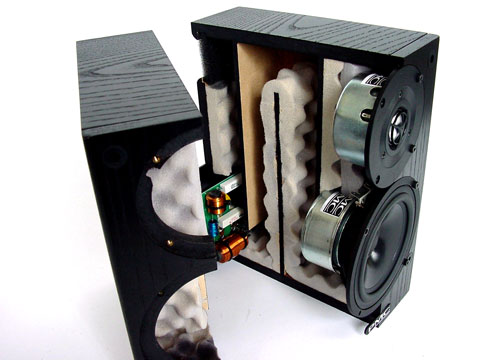
Model DB1 Transmission Line Cutaway
Thinking Inside the Box
The gist of a transmission line design is that the rear of the woofer fires into the ‘line', i.e. a pipe whose length relates to the largest of low frequency waves, which can be lengthy indeed. In the real world this length is achieved by a combination of folding the line and including acoustically absorbent material in the interior of the transmission line itself. This design progressively absorbs higher frequencies while still allowing some of the wave to exit, in phase, at a port on the front of the speaker. There is a small foam-covered port at the bottom of the front panel of the FB1+ that accomplishes this. And in between the driver and this port is a labyrinth that PMC describes as having an "effective line length" of 3 meters. That's 9.8 feet friends! That would be a VERY LARGE horn design. However, PMC has developed proprietary materials that create an "effective" acoustical length that occupies less cabinet space.
I recommend going to PMC's website where they explain their "Advanced transmission Line" or ‘ATL', at: www.pmcloudspeaker.com/transmission.html. Here are some excerpts from that summary:
"The transmission line is the theoretical ideal and most complex construction to load a moving coil loudspeaker.... The most practical implementation is to create a long tunnel within a cabinet by introducing internal partitioning that folds the line up and down the length of the cabinet.... The main driver is placed at one end of the TL, which is heavily damped with absorbent acoustic material.... The foam...must be exactly specified to ensure a consistent and balanced backpressure.... When this equilibrium is achieved between length of line and the acoustic absorbency, the air density increases.... This backpressure holds the main driver in a vice-like grip and the control is effective over a huge frequency range, reducing unwanted cone movement which lowers audible distortion. This lack of harmonic distortion in the (low frequencies) creates superb midrange clarity as it eradicates the effects of masking."
Obviously there are plenty of touchy factors here, with plenty of room for audio voodoo as well. When a transmission line approach is poorly executed, you know it is going to sound awful! It becomes like the worst of the cheap reflex-loaded offenders, with boomy bass and inappropriate resonant ‘tuning' hot-spots. I think the obvious challenges of the required construction and experimentation have been enough to discourage many audio designers from going down this particular path. Otherwise, I don't quite know how to explain the relative scarcity of transmission-line designs in the high-end audio world.
When I explained to Miles Roberts of PMC what I have been hearing with the PMC FB1+'s in my living room, he commented that "With the transmission line designs you get a nice smooth roll-off, and it just keeps rolling off down to infinity. So your ear is thinking that there are far more sub-harmonics than there are. But this allows you to get a very even balanced tone and sound. As you are listening you are probably finding it quite easy to tune into different elements of the music."
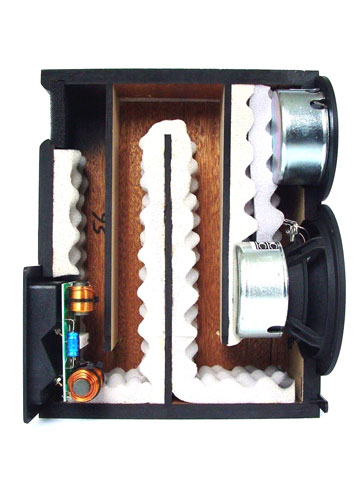
Another DB1 Transmission Line Cutaway View
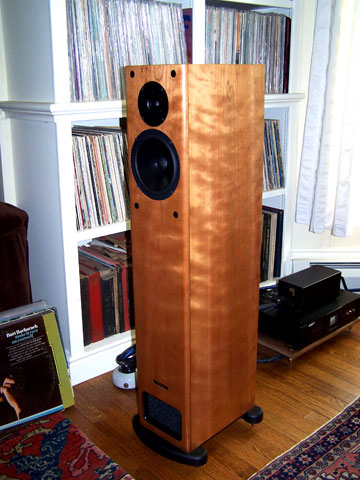
Stop Me Before I Get Carried Away
I have had the pleasure of auditioning these speakers with two fine Cary Audio single-ended triode amplifiers. This included my CAD 805 Anniversary Edition monoblocks, and also a pair of Dennis Had's latest monoblock design, here with me for review. These utilize the 45 Triode tube for output, and are designated as CAD 45SE's, (of which more in a separate review soon). I also compared the PMC FB1+ to my Sonus Faber Grand Piano floor-standers which I still had on hand. The two speakers are almost identical in height and width. Driver-wise, the Sonus Faber is a ‘two and a half'-way design, i.e., two identical woofers that cross-over at different points, and as I mentioned, the two speakers seem to share almost identical tweeter units, mounted at almost identical heights from my listening position. All in all, a very telling comparison. I should note that the Sonus Faber I was listening to is not the newly offered ‘Domus' model, but the now-previous model, the ‘Concerto Home.'
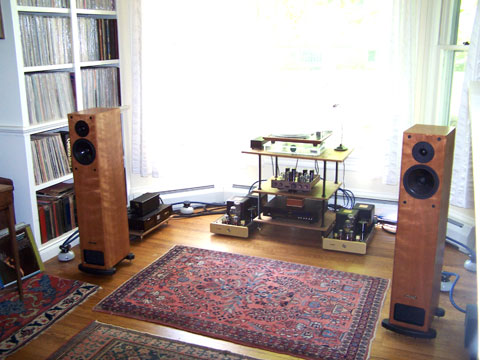
The FB1+s Take Their Place
Here are some of my raw listening notes:
Shirly Horn, "Here's To Life" (Verve ‘92 /CD)
(CAD 45 SE's with FB1+)
From the title song—in the first verse, after "give it all you've got," Shirley mouths a small "Uhnnn"; I never heard that before! No sibilance problems, and this recording, as great as it is, is slightly on the "sssy" side of things, particularly with less-than great gear. Shirley's vocals were still extremely breathy. Glistening strings from the superb Johnny Mandel arrangements, approaching vinyl transparency. Extremely ‘black' backgrounds.
(Same as above compared with Sonus Faber Grand Pianos)
More upper bass/mids, ‘darker'. More sibilant. Less from Bass Clarinet. Less violin harmonics. Less air from the winds. More dB's in the vocal range, relative to lows and highs, (noting that the Grand Pianos double up in that region with their ‘2+1/2-way' design)—which is more real?! Shirley more ‘in the group' with the PMC's than with the Sonus Fabers.
Mahler - Symph. #7, Mvt. I (Tilson Thomas / S.F. Symphony ‘06 / CD)
(CAD 805's with their 211 output tubes/Sonus Faber Grand Pianos)
Sure is dark! Great biting low strings, but lacking some definition. More-so from upper strings. Horn solos very mellow. ‘Sleigh-ride from Hell' stuff lacks bite. Strings lacking in harmonic detail, bowing less present. Definitely not fatiguing sound though.
(Same as above, switching to the FB1+'s)
More dynamic contrasts, as in the opening ‘oar-strokes of fate'... More upper partials from the strings, more bowing. More defined Bass Clarinet. More ‘contour' from the Horn solos. Higher and deeper soundstage. The Timpani were more defined with crisper mallet attacks. ‘Sleigh-ride' stuff now has that Mahlerian dervish quality. Upper strings don't feel ‘padded', feel more real.
Bruckner - Symph. #4, Mvt. I (Jochum / Dresden / EMI CD)
(CAD 805's with the 845 output tubes / PMC FB1+)
That opening—like a wonderful spring ‘hatch' on the Beaverkill (NOT like a buzzing cloud of mosquitoes). (Note to self: Fly fishing ‘flies' have a lot in common with moving coil phono cartridges—both are trying to ‘catch' things with coils and needles and hooks; I am sure some of those Japanese cartridge makers could tie a mean fly...)
Count Basie - "Fancy Pants" (Pablo ‘83 LP)
(CAD 805's with 211 output tubes / PMC FB1+)
Another great late-Basie recording engineered by Allen Sides at Ocean Way Studios in Hollywood. Nice to hear, other than the better known "88 Basie Street". Velvet glove glow! Biting horns, maple syrup sax, poppin' bass, cookin' drums. ‘In the Room!', in all it's varied close-miked glory. The sax section blends are welded in air....enough to make you pull out the good Scotch—and this was at noon on a Sunday!
The Pretenders - (Sire / ‘79 / LP)
(CAD 805's with 211 outputs / PMC FB1+)
Can the FB1+'s rock? Yup. Chrissie Hynde's leather mezzo right there. Compressed guitars stay compressed—truth in recording reproduction. "Maybe, maybe I'm gonna have a baby!" Every lyric and double-tracking trick by producer Chris Thomas is right in front of you. Can feel how the mix is balanced in favor of the vocal; result—a hit! When Chrissie hits her upper range vibrato/whine it becomes positively operatic. The drum breaks & hand claps work. Maracas are snappin'! Not for the first, or last, time I notice that interplay between the kick drum and the bass that I've only read about—until now.
The Grateful Dead - "Fillmore West, March 1, 1969" (Grateful Dead HDCD)
(Same combo as above)
O.K.—The PMC's can rock—but can they jam?! 1969 was the peak year for the Dead's full-tilt psychedelic 2-drummer juggernaut iteration. This is from disc 6 of the 10 disc box set covering the entire weekend from which most of the "Live/Dead" Warner Bros. album was taken. Recorded on one of the first available Ampex 16-track decks; to this day many people feel this is one of the very best sounding rock recordings. I agree. So how does this music do with a single-ended triode amp (putting out at decent 70 watts or so of triode juice) driving the FB1+'S? "That's It for the Other One"—Phil Lesh's trademark thundering opening ascending bass run hits like a Wagnerian sledgehammer wielded by a very high Wotan, in all its 5-string magnificence. I don't think I can top Sam Tellig's favorite adjective here—"killer!" The dual-drummer 747 taxi's on down the runway and then, we're airborne! Or as Phil Lesh said directly to me, as I leaned on the rail as a young teenybopper and The Dead rose up on the hydraulic orchestra pit stage in the Berkeley Community Theater, right about this same time in 1969: "We aren't in Berkeley anymore."
Jefferson Airplane - "After Bathing at Baxter's" (RCA ‘69 / LP)
(Same combo as above)
The other twin bass player pillar on which the San Francisco Scene rested of course, was Jack Casady, whose low locked-in cruising grooves were for me, and others, a highlight of hearing the Airplane live, at their best. This great album has always sounded somewhat compressed and truncated on the low-end—until now. With the aid of the FB1+'s, I was able to extract that extra bit of juice that put the foundation back in the music, and brought this stuff to life like I haven't heard it since I heard them perform it live, back in the ‘hood. (I grew up in Berkeley in the ‘60s, and this has made me the stable well-rounded individual I am today—wouldn't trade it for the world!) "Won't You Try", "Saturday Afternoon"—great stuff, with an operatic/improvisational quality in the vocals from Grace Slick and Marty Balin that remains unique in the increasingly uptight world of rock & roll. The PMC's did a wonderful job of sorting all that out and putting the breath of life back into it.
Steely Dan - "Gaucho" (MCA ‘80 / LP)
(Same combo as above)
O.K., so the FB1+'s can jam, but can they play tight jazz/rock fusion stuff exhibiting the best studio production? Yup. You all know this album—that is one reason I picked it off the shelf. Recorded, (thank God), right before the dawn of the digital era, Donald Fagen and Walter Becker work their obsessive studio musician magic. For me, Aja is the greater album, but what the heck, "Babylon Sisters" is a great cut, even if one of my songwriting students once reacted by saying it sounded like a porno film soundtrack. Or maybe Don Fagen would take that as a kind of compliment? True story—I recently ran into Donald Fagen dining in the lobby type area at the Carlyle Hotel in Manhattan. I thanked him for extending triadic harmony in rock & roll to include 9th and 11ths, and he said to me, "Yeah, even a 13th."
The female background vocals on this album open their arms (?) to embrace you, and the kick drums and toms lock it down, along with Fagen slapping on his Fender Rhodes. Interplay between the Bass guitar and the Kick drum is such a key part of pop music, and one I've been missing the visceral effect of.
Aretha Franklin - "I Never Loved a Man the Way I Love You" (Atlantic / 4 Men With Beards - LP Reissue)
(Same combo as above)
O.K., so the FB1+'s can play tight jazz/rock fusion stuff, but can they do the most soulful female R&B ever recorded?! Yup. Quite frankly the title song was an electric shock to the crotch. "How could you hurt me so bad....Kiss me once again/Don't you never never say that we're through." I mean really—it doesn't get better than this, and if you wouldn't respond to this the way I just heard it reproduced through the FB1+s, then you are extremely white, and are obviously suffering from a bad case of ED...... Hmmm, has Sasha finally gone to far? I'm just trying to generate a little mail after all...The horns are very horny sounding, right there in the corner of that studio in Muscle Shoals—YES, Jerry Wexler and Tom Dowd! No sibilance problems, just ‘in the room' gospel intimacy with Aretha's strong STRONG mezzo meets lyric soprano voice. Enough to make boys into men, and then make those grown boys cry! You're gonna love it.
The Band (Capitol ‘69/LP)
(Same combo as above)
O.K., so the FB1+'s can play the most soulful female R&B ever recorded, but can they take you to that special place , my favorite musical stomping ground of all—the 2nd great Band album from 1969? Yup. Welcome to that small cozy room where some of the greatest American music ever made got recorded. No matter, that it turns out it was in Sammy Davis' pool-house. Catskills / Hollywood Hills...what the hell, at least they're hills. This is it for me, the deepest, most significant musical experience, one that I shared with my best buddies in high school when it was new. Heard The Band themselves perform this material at the Berkeley Community Theater—and they played the heck out of it.
So what do I hear through the PMC's? That tight focused deeply soulful drumming of Levon Helm, not to mention his deeply soulful vocals. Ringo Starr admired that muffled drum sound—turns out that indeed the drums had towels on ‘em and so forth. Then the red coals of Garth Hudson's genius keyboarding, weaving in and out of the group. All right there again in my living room. Levon's kick drum whacking it into its funky reality. And the most emotionally cutting part of it all perhaps, star-crossed Richard Manuel's heartfelt keening. Not even the fact that Capitol Records had recently changed their LP logo from the rainbow to that lame lime-colored thing, can subtract one iota from the unique greatness of this stand-alone masterpiece. And the FB1+'s took me back to all of that. What a great feeling, what a great reason to go to all the trouble and expense of having a high-end audio system in the first place!
Sasha Matson - "Spell For Orchestra"
O.K., so the FB1+'s can take you to that special place, but can they play my music? Yup. A few weeks ago I had the pleasure of hearing my composition Spell For Orchestra performed in my area, by The Catskill Symphony conducted by Charles Schneider. I wrote the music, I heard it rehearsed and performed, and I have now heard a recording reproduced through the FB1+ loudspeakers on my reference system. Now these speakers have had the opportunity to live up to their pro monitor heritage. When I heard the un-edited, un-mixed raw recording, it was too much of the ‘Mercury Living Presence' in-your-face sound for my taste. The orchestra had been very close-miked. So I knew, from what the FB1+'s told me, that I needed to sweeten the upper strings a bit, boost the low-end extension on the low strings a bit, and add an appropriate amount of "warm hall" reverberation. So I did that with the engineer, brought back the re-mixed recording, and checked it. And I know that we improved that recording; it now is much closer to the actual sound I heard in that hall, at that actual performance, and is far more listenable. The PMC FB1+ loudspeakers assisted me in doing that. I don't know what more positive thing I can say—I trust them with my own music!

My Cherry FB1+’s (The Veneer that is....)
Things You Need to Know About the PMC FB1+ Loudspeakers
1.) These loudspeakers are very sensitive to toe-in and room positioning, vis a vis side-wall reflections. Make sure the relevant distances are identical from your listening position, for the best imaging and staging. It is not a case of a small ‘window', but rather a place and angle where these things will interact with your ears and your room in a way that really is jaw-dropping. I know, because I thought I had them set, and recently moved them slightly because I wanted to tighten the floor spikes, and voila—even tighter deeper soundstage and low-end extension kicked in.
2.) The FB1+'s require a long break-in period—I'm talking in the 200 hour ballpark rather than the customary 100. Be patient. Until they "come around for you", as Brian Smith at Audio Classics Ltd. put it, these speakers will appear to be guilty initially of a bunch of speaker no-no's. Early on they will sound harsh, etched, with a bleached mid-range, etc.... Then they turn the corner and its magic time. Why is this? My hunch is that this has something to do with the transmission line's grip on the woofer, such that it takes longer to loosen up. But whatever the technical reason, there truly is a real break-in period with these loudspeakers that you will need to take into account. But when these things open up and simmer down, look out; you will be simply amazed at the incredible combination of dynamic fireworks and precision imaging, along with real actual tactile beauty in the harmonics.
3.) Toe-in. In regards to #1 above, though your room and listening position may yield a different result, I agree with the other writers who felt that what ended up working best with these speakers is a slight to moderate amount of toe-in, one that aims the speakers at an imaginary point quite some distance behind the listener. Too much, and all sins listed in #2 are going to seem to be happening, too little, and you are going to lose the fantastic holographic imaging these speakers are capable of and bred to produce, just like the recently banned fox-hounds of that fair isle. One pejorative you can just throw on the dustbin right now—the phrase ‘polite British studio monitor'. If it ever applied, it certainly does not with the PMC FB1+.
Lunchtime
Is this a free lunch? No, these things still carry price tags, though I think reasonable ones. Is the cabinet-making at the same level of Sonus Faber, Verity Audio, or others in the very upper end of the high-end? No it isn't, but bear in mind that you pay a hefty premium for that kind of cabinetry, as handsome as it may be. However, in the case of PMC's transmission line designs, there is a direct hidden benefit due to the nature of the folded internal transmission line. The resultant comprehensive internal bracing of the cabinet is a real advantage to the listener. In other types of speaker designs this kind of substantial bracing may be added almost as an engineering afterthought. This is another example of intelligent design I think; there is literally more here than meets the eye—but it sure meets the ear! The balancing act that makes the FB1+ such a special performer is the combination of extraordinary imaging and clarity achieved by a high quality two-way driver design, wedded to full-range, ultra-even frequency coverage with lifelike dynamics. This results from the correctly executed transmission line. Perhaps no free lunch, but assuredly an opportunity for having, and also eating, cake.
 In breaking in these speakers, and listening
to them over time, I had to re-calibrate my ears. As I noted above,
there are definite break-in behaviors, and those I was ready for.
Honestly though, I had initial doubts that these were the right
loudspeakers for me, given my musical tastes. I was missing the
mid-range lusciousness that I had become accustomed to with my Sonus
Faber's, which is an aspect of those fine Italian designs. I
perceived that difference as a lack of human warmth, particularly in the
vocal range. But this is a question often of apples and oranges, of
glasses half empty or half full. Some term the overall sonic signature
of a loudspeaker its presentation, and this was very different
from what had proceeded it in my living room, in the case of the FB1+'s.
Now, having grown accustomed to what I do believe to be a more even
distribution, a truer representation of the musical performances, there
is no going back. The FB1+'s feel honest and correct, with no portion of
the harmonic spectrum getting undue attention. Just as I don't feel the
need of tone controls on my pre-amp, I don't want my loudspeakers to be
acting as tone controls in any sense; vocals and every other musical
element need to be in their proper balance, reflecting and ‘presenting'
the performance as it occurred in reality. As elusive as this goal is
aesthetically, the PMC FB1+ does a great job of getting you there.
In breaking in these speakers, and listening
to them over time, I had to re-calibrate my ears. As I noted above,
there are definite break-in behaviors, and those I was ready for.
Honestly though, I had initial doubts that these were the right
loudspeakers for me, given my musical tastes. I was missing the
mid-range lusciousness that I had become accustomed to with my Sonus
Faber's, which is an aspect of those fine Italian designs. I
perceived that difference as a lack of human warmth, particularly in the
vocal range. But this is a question often of apples and oranges, of
glasses half empty or half full. Some term the overall sonic signature
of a loudspeaker its presentation, and this was very different
from what had proceeded it in my living room, in the case of the FB1+'s.
Now, having grown accustomed to what I do believe to be a more even
distribution, a truer representation of the musical performances, there
is no going back. The FB1+'s feel honest and correct, with no portion of
the harmonic spectrum getting undue attention. Just as I don't feel the
need of tone controls on my pre-amp, I don't want my loudspeakers to be
acting as tone controls in any sense; vocals and every other musical
element need to be in their proper balance, reflecting and ‘presenting'
the performance as it occurred in reality. As elusive as this goal is
aesthetically, the PMC FB1+ does a great job of getting you there.
How do the FB1+'s achieve the subtle performance of micro-dynamics that some audiophiles cherish above all in horn and electrostatic designs—and at the same time provide exceptionally large and truly flat bandwidth and dynamic performance that others value from the gigantic reflex boxes—all with one medium-sized driver and one lil' ‘ol tweeter? Damned if I know, but again I think the benefits can be traced to a transmission line approach that actually works.
How good do I think the PMC FB1+ is? This good—I put my money where my mouth is, before I even opened it! Before I sat down to write these thoughts, I had already taken my Sonus Faber Grand Piano speakers (which I enjoyed every minute of my time with), to my friends at Audio Classics Ltd., and traded them in on the FB1+'s, just like anyone reading this article can do—with no ‘industry accommodation' pricing whatsoever. I am now hearing what I was missing previously; a true ‘foundation' in the low frequencies. Simultaneously, I am hearing greatly increased clarity and precision from the middle and upper frequencies, and a related increase in ‘visibility' of the soundstage. The FB1+ excels at both macro and micro dynamics, and that is what we want from any true high-end loudspeaker. This total end-result is truly exceptional at this price point. These speakers are extremely flexible—they are tools for evaluating the actual objective content and quality of both recordings and hardware, and in that sense they do fulfill their monitor heritage. These are aspects that I consciously seek from music reproduction, not things I try to avoid.
You will want these things too, when you have a chance to hear what you might also have been missing. Full-range musical magic, at an outstanding price—great work Peter Thomas and PMC! Sasha Matson
PMC Model FB1+ Loudspeaker
Retail: $3300 per pair
PMC Limited
43-45 Crawley Green Road
Luton, LU2 0AA
England
TEL: +44 (0) 870 444 1044
email address:
[email protected]
web address
www.pmcloudspeaker.com
